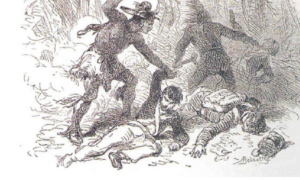A History of Fort Meigs
Construction Begins
First Siege
In late April 1813 the British, under command of General Henry Proctor, arrived to begin a siege of Fort Meigs. Traveling down from Fort Malden, Upper Canada, they made camp in the ruins of old Fort Miamis on the north side of the Maumee River. On the morning of May 1, British artillery opened fire on the American installation. The bombardment carried on for five days, but the Americans within the fort held on until reinforcements, in the form of 1,200 Kentucky militia, arrived along the Maumee. These reinforcements fought several engagements on both sides of the river. Wednesday, May 5, 1813 marked the bloodiest day of the siege. During the course of the fighting, nearly 600 men were lost to a combined force of British regulars, Canadian militia, and American Indian warriors. Despite this major loss to the Americans however, many American Indians lost interest in the siege. After a few more days the British and their Native allies were forced to withdraw, leaving the Americans with a victory. The British and their allies would not return to Fort Meigs again for close to two months.
Second Siege
In July 1813, the British and American Indians attempted a second siege of the fort. Instead of an artillery barrage, this attempt used subterfuge. Hiding outside of the fort in the nearby woods, Natives, under the leadership of Tecumseh, staged a mock battle. This included the firing of muskets, war cries, and other sounds of struggle. The intent was to fool the Americans into leaving the fort and draw them into an ambush. Instead, the American army fortified itself in the fort and did not leave. Eventually a strong thunderstorm moved into the area and forced the British and American Indians to again withdraw. With two victories now, the Americans were prepared for a counter-attack.
The Second Fort Meigs
Fort Meigs was torn down shortly after the second siege and was rebuilt on a smaller scale. Instead of a full fort it would stand as a supply depot till the end of the war. With this second fort built, the American army marched north towards Canada, leaving 100 Ohio militiamen behind to guard it. This supply depot stood till the end of the war, and was then abandoned by the American army. The fort, after having its property change hands several times, was eventually reconstructed in the 1970s, rebuilt again in the early 2000s, and now stands to educate about the War of 1812.
"[To] General Harrison: When the impartial historian records his preservation of Fort Meigs the reader will find a monument which no time can decay."
~ Celebratory Toast given
July 4, 1813
Photo credit: Weaver


![Seige [sic] of Fort Meigs by D.W. Kellogg & Co., 1845. From the Anne S. K. Brown Military Collection, Brown University, Providence, Rhode Island.](https://fortmeigs.org/wp-content/uploads/2021/04/siege-of-fort-meigs-1-300x221.jpg)